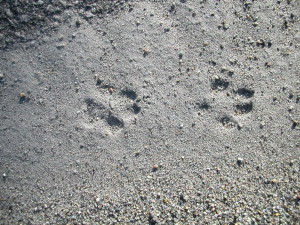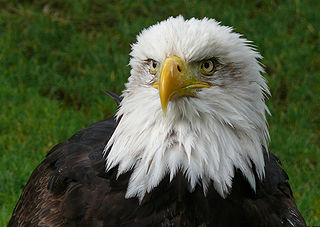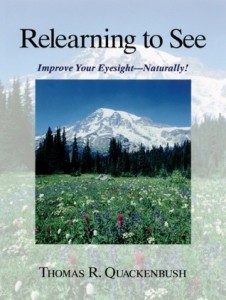![]() Related to the issue of how to see, which is the subject of natural vision, is the idea of what to see or what to look for. Since our visual field is so crowded, we must necessarily be selective in what we take notice of. Yet modern humans have developed an insouciance about the natural environment which reflects a belief that there is nothing important to take notice of.A coyote on his daily trot through highly familiar territory gleans a great deal of information about what has transpired since he last made the rounds. He knows not only what types of animals have passed through, but how long ago they were there, where they came from, where they went, and what they did in that particular spot. True, a lot of the coyote’s information comes from his superior sense of smell, which we cannot hope to emulate, but with our primary tool of perception, our vision, we can also discern these stories. Seeing an animal is a gift, yet recognizing the signs of an animal traversing the vicinity is also valuable information that can lead to future sightings. And identifying the name of the animal is only part of the equation; the signs also point to a story about that animal.
Related to the issue of how to see, which is the subject of natural vision, is the idea of what to see or what to look for. Since our visual field is so crowded, we must necessarily be selective in what we take notice of. Yet modern humans have developed an insouciance about the natural environment which reflects a belief that there is nothing important to take notice of.A coyote on his daily trot through highly familiar territory gleans a great deal of information about what has transpired since he last made the rounds. He knows not only what types of animals have passed through, but how long ago they were there, where they came from, where they went, and what they did in that particular spot. True, a lot of the coyote’s information comes from his superior sense of smell, which we cannot hope to emulate, but with our primary tool of perception, our vision, we can also discern these stories. Seeing an animal is a gift, yet recognizing the signs of an animal traversing the vicinity is also valuable information that can lead to future sightings. And identifying the name of the animal is only part of the equation; the signs also point to a story about that animal.


Month: September 2013
Seeing More Clearly
September 20, 2013
Animal Stories and Spirit Journeys
September 13, 2013![]() Interview on Attune Magazine with Mary Nale and ReeNee Cummins.This interview is about an hour. We talk about some of the basics of animal magic. What is Euro-shamanism? How does it relate to healing? How do I interpret my experiences with animals? Also some discussion of owls, spiders, snakes and alligators.
Interview on Attune Magazine with Mary Nale and ReeNee Cummins.This interview is about an hour. We talk about some of the basics of animal magic. What is Euro-shamanism? How does it relate to healing? How do I interpret my experiences with animals? Also some discussion of owls, spiders, snakes and alligators.
Relearning to See
September 6, 2013 This isn’t so much a review of Thomas R. Quakenbush’s book Relearning to See, considered one of the best books explaining what is called the “Bates Method,” as it is an exploration of how the principles of natural vision have changed my thinking and my life. Although most people will elect to go the route of glasses and surgery to correct vision problems, and a few lucky people have perfect vision without considering the issue, I think these insights have implications beyond correcting eyesight, implications especially for the magical practitioner.I first decided to use natural vision methods over twenty-five years ago, when I was at the Michigan Womyn’s Music Festival. I was camping out at the festival with several thousand women, and I rolled over my glasses in the tent while I was asleep, breaking them beyond repair. I was a day’s drive away from home, and my girlfriend did not know how to drive, so I had no idea how we would be able to get home. I was in a bit of a panic. In the end, some women scrounged up materials and pieced the glasses together so that they could stay on my nose long enough for the drive – but that was the turning point. I saw that my life was hanging by a thread, depending on these implements to interface with the world, and I vowed that I would find a way to emancipate myself from the tyranny of eyeglasses. I had never heard of “natural vision,” and I didn’t know anyone who had successfully thrown away their glasses, but I was determined to be free.Looking back, I can see that it was no coincidence that my commitment to better vision began here, just as it was no coincidence that my vision problems started in my first year of college. That year I began complaining of headaches, and my mother made an appointment for me at the “Vision Clinic,” as it was misnamed. It should have been called the “Adjusts to Poor Vision Clinic.” Sure enough, my eyesight had deteriorated. The explanation given was that I was spending long hours hunched over books, often under the glaring light of the library, and this was putting a strain on my eyes. I don’t dispute this explanation, and William H. Bates himself says that eyestrain is a big culprit in poor vision, but this is a surface explanation, like saying your car got dented because something hit it. What happened?College is a period of indoctrination as much as a period of learning. The biases, prejudices and imperatives of Western civilization bombard the young mind, as the institution struggles against itself to teach that mind how to think while dictating to it what to think. Especially for a woman, the incongruities are fierce. I took what amounted to a minor in English literature, and in all those classes read exactly one book written by a woman. The thing that bothers me most about that is that I didn’t “see” it. I majored in economics, and it was never mentioned that most wealth is in the hands of men and poverty disproportionately affects women. What bothers me now is that I didn’t “see” it. For a woman higher education is a period of great strain, one she survives by turning a blind eye, or at least a myopic one, to what is going on.Since I had not been inured to wearing glasses at a young age, of course I hated them, and I only wore them when reading a textbook – something that should have been instructive. When I graduated from college and began working for a large corporation, I began needing higher prescription lenses to read it all, and eventually needed glasses even to drive.Michigan provoked the turn around. This was in the earlier days of the festival, before the rise of organized attacks that changed the timbre of the music. I had to never been in a crowd of so many women. I had to never been in a large public gathering where men were completely absent. I realized with a shock that for many years, perhaps most of my life, I had lived in heightened alert against the threat of rape, both in and outside of my house. I had never reflected on this, never even noticed it, but the absence was startling. My body was conditioned to tighten at the sound of a low voice or a rustle of leaves – but then I would remember, “I am safe here.” This is what the early days of Michigan were like.It was also at Michigan that I met my first witch, or at least the first witch who would talk to me. I had imposed myself once on a woman who was pointed out to me at a local coffee house, who admitted to being a witch. I asked her where I could learn how to fly on a broom, and she brushed me off. But at Michigan there were lots of witches. I took a tarot class taught by Daughters of the Moon designer Fiona Morgan. I remember nothing about the class except that I felt excited to catch a glimpse of some thing totally new. Something was shifting in me. Looking back I see that my fuzzy eyesight was the distortions of patriarchy and my eyeglasses were the coping mechanism that allowed me to function. I left Michigan determined not to throw away my coping mechanism, but to dispense with the need for it altogether. The clearer vision that ensued allowed me to penetrate the occult realms.As often happens when I write a blog post, I have discovered that I have more to say than I thought I did. I will continue the topic of acquiring clear vision in another post.
This isn’t so much a review of Thomas R. Quakenbush’s book Relearning to See, considered one of the best books explaining what is called the “Bates Method,” as it is an exploration of how the principles of natural vision have changed my thinking and my life. Although most people will elect to go the route of glasses and surgery to correct vision problems, and a few lucky people have perfect vision without considering the issue, I think these insights have implications beyond correcting eyesight, implications especially for the magical practitioner.I first decided to use natural vision methods over twenty-five years ago, when I was at the Michigan Womyn’s Music Festival. I was camping out at the festival with several thousand women, and I rolled over my glasses in the tent while I was asleep, breaking them beyond repair. I was a day’s drive away from home, and my girlfriend did not know how to drive, so I had no idea how we would be able to get home. I was in a bit of a panic. In the end, some women scrounged up materials and pieced the glasses together so that they could stay on my nose long enough for the drive – but that was the turning point. I saw that my life was hanging by a thread, depending on these implements to interface with the world, and I vowed that I would find a way to emancipate myself from the tyranny of eyeglasses. I had never heard of “natural vision,” and I didn’t know anyone who had successfully thrown away their glasses, but I was determined to be free.Looking back, I can see that it was no coincidence that my commitment to better vision began here, just as it was no coincidence that my vision problems started in my first year of college. That year I began complaining of headaches, and my mother made an appointment for me at the “Vision Clinic,” as it was misnamed. It should have been called the “Adjusts to Poor Vision Clinic.” Sure enough, my eyesight had deteriorated. The explanation given was that I was spending long hours hunched over books, often under the glaring light of the library, and this was putting a strain on my eyes. I don’t dispute this explanation, and William H. Bates himself says that eyestrain is a big culprit in poor vision, but this is a surface explanation, like saying your car got dented because something hit it. What happened?College is a period of indoctrination as much as a period of learning. The biases, prejudices and imperatives of Western civilization bombard the young mind, as the institution struggles against itself to teach that mind how to think while dictating to it what to think. Especially for a woman, the incongruities are fierce. I took what amounted to a minor in English literature, and in all those classes read exactly one book written by a woman. The thing that bothers me most about that is that I didn’t “see” it. I majored in economics, and it was never mentioned that most wealth is in the hands of men and poverty disproportionately affects women. What bothers me now is that I didn’t “see” it. For a woman higher education is a period of great strain, one she survives by turning a blind eye, or at least a myopic one, to what is going on.Since I had not been inured to wearing glasses at a young age, of course I hated them, and I only wore them when reading a textbook – something that should have been instructive. When I graduated from college and began working for a large corporation, I began needing higher prescription lenses to read it all, and eventually needed glasses even to drive.Michigan provoked the turn around. This was in the earlier days of the festival, before the rise of organized attacks that changed the timbre of the music. I had to never been in a crowd of so many women. I had to never been in a large public gathering where men were completely absent. I realized with a shock that for many years, perhaps most of my life, I had lived in heightened alert against the threat of rape, both in and outside of my house. I had never reflected on this, never even noticed it, but the absence was startling. My body was conditioned to tighten at the sound of a low voice or a rustle of leaves – but then I would remember, “I am safe here.” This is what the early days of Michigan were like.It was also at Michigan that I met my first witch, or at least the first witch who would talk to me. I had imposed myself once on a woman who was pointed out to me at a local coffee house, who admitted to being a witch. I asked her where I could learn how to fly on a broom, and she brushed me off. But at Michigan there were lots of witches. I took a tarot class taught by Daughters of the Moon designer Fiona Morgan. I remember nothing about the class except that I felt excited to catch a glimpse of some thing totally new. Something was shifting in me. Looking back I see that my fuzzy eyesight was the distortions of patriarchy and my eyeglasses were the coping mechanism that allowed me to function. I left Michigan determined not to throw away my coping mechanism, but to dispense with the need for it altogether. The clearer vision that ensued allowed me to penetrate the occult realms.As often happens when I write a blog post, I have discovered that I have more to say than I thought I did. I will continue the topic of acquiring clear vision in another post.
